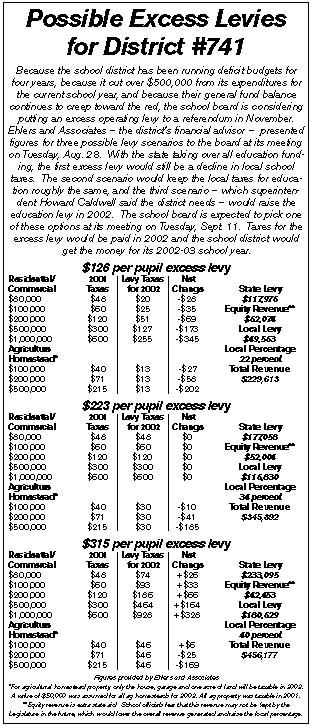District eyes excess levy options
 That local voters will be asked by the school district to support another excess levy seems assured. The question is how much does the school need.
That local voters will be asked by the school district to support another excess levy seems assured. The question is how much does the school need.School board members were presented three options for an excess levy at their meeting on Tuesday, Aug. 28. The board needs to decide by Tuesday, Sept. 18, if the question is to be put on the ballot for an election in November.
Action on one of the three options is likely at the board]s next meeting: on Tuesday, Sept. 11.
Presented to the board were projections made by Ehlers and Associates, the district]s financial consultants. The company ran projections of three levies to see the money generated for the school and the affect on the tax base.
The three projections were a $126 per pupil levy, a $223 per pupil levy, and a $315 per pupil levy. Each of these would provide additional revenue for the local schools through state aid and an additional local levy.
The school district currently has a $315 per pupil excess levy, but this will be rolled into the state]s education funding starting next year. The state wiping that slate clean, the other cuts in property taxes, and the need for extra revenue at the school are seen by the board as selling points for the new excess levy.
Because of the statewide property tax reform, whereby the state government picks up all of education funding, the education portion of local school taxes would be nothing next year without a new levy, according to Ehlers and Associates. Even if the $126 levy would pass, taxpayers would see lower local education taxes.
Because the education levy no longer includes seasonal property or ag land (except for the house, garage, and one acre of land), lake homeowners and farmers should see education tax reductions despite an additional levy.
The $126 projection would also maximize state aid at nearly 78 percent of the levy. This would leave 22 percent to be paid by local taxpayers. The other levies would get 66 percent and 60 percent state funding.
The next option - $223 per pupil - was chosen because it keeps local education taxes the same as last year. This option would ask voters to return their education tax relief in the form of increased aid for the local schools.
The last option - $315 per pupil, chosen because it is the same amount as the district passed in 1997 - would actually raise the education taxes for most people.
Superintendent Howard Caldwell said this option would be the best for getting the school out of debt and back on budget. "We need to obtain a balance and we need to keep it," he explained.
The $315 levy - for taxes payable in 2002 - would generate $456,177 dollars for the 2002-2003 school year. Caldwell said the school needed that much to get back on its feet.
The school district cut over $500,000 from its budget last winter and may cut more this year, even if a referendum passes. One of the board]s goals is to set a policy that would require budget cuts as the enrollment drops.
Enrollment this year will be down 50 students, about $150,000 to offset in cuts, said Caldwell.
While never easy, massive cuts get progressively harder. "As we go further into (budget) adjustments, we]re going to find we]re going to deal with the elimination of programs," said Caldwell.
Several board members have blamed the state for playing a shell game: giving tax relief while underfunding schools, which in turn forces the school districts to raise the local levy.
Other board members were reluctant to keep heading to the voters for more money. "I look at this as a temporary fix," said board member Dan Andersen. "This is only half of the solution. This gets us in the black, but once we get there, how do we stay in the black?"
The deciding questions, according to Deb Glenz, the acting chair of the board at their last August meeting, is how much the school district needs, how much will taxpayers have to pay for the levy and how much the community will support. Then the board will have to focus on educating the public on why they need the excess levy.
A decision to put an excess levy on the November ballot would almost certainly be made at the board]s next meeting. The board could also hold a mail-in ballot anytime throughout the year, or if it falls into statuatory debt it would be exempt and could hold an election later in the school year.
Contact the author at paypress@lkdllink.net • Return to News Menu
Home | Marketplace | Community